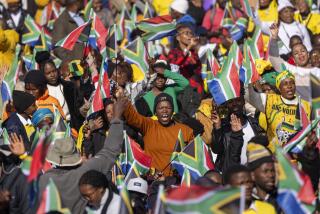Chipping Away at Apartheid’s Cornerstone : By RICH MKHONDO
- Share via
JOHANNESBURG — The reform candidates running against the National Party in Wednesday’s whites-only parliamentary election have at least one thing in common: They want the South African government to speed the dismantling of apartheid.
Most of these candidates promise that if elected they will push for accelerated reform. And most also agree that no reform can be achieved unless the Group Areas Act, the heart of apartheid, is abolished.
This also is the position of a rising tide of dissenters like Willem de Klerk, who resigned last month as editor of the only Afrikaans Sunday newspaper, as well as 28 influential Stellenbosch University professors who have called for apartheid’s end.
De Klerk believes that no reform is possible unless the Group Areas Act and the Separate Amenities Act are scrapped. The Stellenbosch professors have called on the white-minority government to abolish apartheid and share power with black South Africans.
The Group Areas Act remains apartheid’s cornerstone. Of all South African laws, it has had the most tangible and direct effect on living patterns here.
As President Pieter W. Botha said: “Let us by all means make the act more flexible, but let us cling fast to this cornerstone of our social system.” But as the act becomes more flexible it is not being as broadly or strictly enforced. The cornerstone of apartheid may itself be crumbling.
The Group Areas Act--first enacted in 1950, shortly after the National Party took power--provides the legal basis for segregated residential and business areas for whites, Africans, Coloreds and Indians. The law also defines where members of these groups may attend a movie or dine, as well as conditions for socializing and participating in racially mixed athletic competition.
Under the act, people must vacate their homes or businesses if the area is proclaimed exclusively for occupation by another racial group. Most recent figures show that only about 2,200 white families have been moved from their homes and resettled in group areas, while 74,900 Colored families and 35,100 Indian families have been forced to move. Only 21 whites have been removed from business areas, while 129 Coloreds and 1,970 Indians have had to move.
One of the worst examples of upheaval under this act occurred in 1966, in a section in the heart of Cape Town known as District Six. It had been occupied by Coloreds since 1834, and had a Colored population of 61,000, but only 800 whites. When the area was proclaimed white, the Coloreds were ordered to move 10 miles outside Cape Town.
Since then an informal process of integration has taken place, particularly in urban apartment-house neighborhoods. A recent Rand Afrikaans University study found that 10,000 Coloreds, 7,000 Indians and 5,000 blacks were living in designated white residential areas of Johannesburg.
Prosecutions under the Group Areas Act also are declining since a Supreme Court ruling that eviction could not follow a conviction unless alternative accommodations were available. There is an over-supply of 300,000 homes in white areas of South Africa, and a shortage of 600,000 homes in black residential areas.
The government also is accepting recommendations by a state-appointed commission that land zoned for industrial use in controlled areas not have a racial character. A 1984 section of the Group Areas Act has been altered to allow for free-trade areas, and more than 60 central business districts have been opened to entrepreneurs of all races.
Other laws that formed the structures of apartheid have been repealed, including those prohibiting racially mixed marriages and sexual relations. Influx-control laws, which controlled peoples’ movements, are no longer in force.
But the Group Areas Act remains as one of the three major pillars of apartheid, along with the Reservation of Separate Amenities Act, which maintains segregation in public facilities, and the Population Registration Act, which designates a person’s race and therefore controls his life. If the reformists win some political power this week, the Group Areas Act may be weakened further. And if that happens it could topple apartheid’s whole structure.
More to Read
Sign up for Essential California
The most important California stories and recommendations in your inbox every morning.
You may occasionally receive promotional content from the Los Angeles Times.













